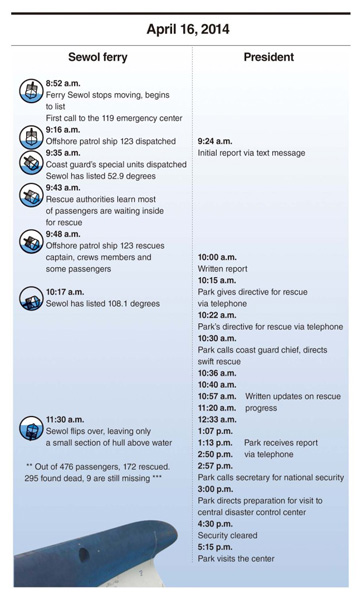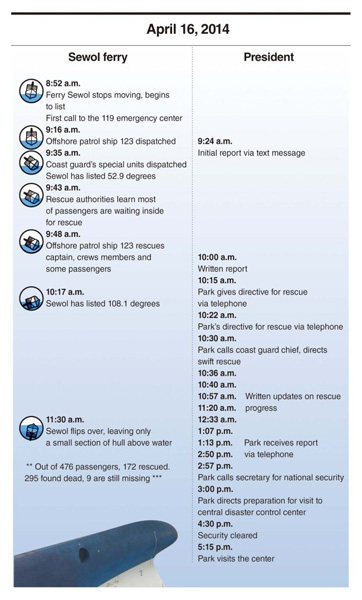Two years and seven months have passed since April 16, 2014, the day when a passenger ferry sank in waters off the southwestern island of Jindo, leaving 295 dead and nine missing.
South Korea still remembers the trauma of the Sewol ferry disaster, not only due to the number of victims — most of whom were young students on a school trip — but also because their deaths may have been prevented or at least minimized if due measures had been taken in time.
Now, with a political scandal unfolding at the highest office of the country, the attention of the public is returning to the day of the accident, as there are suspicions President Park Geun-hye’s incompetence or negligence of duty may have led to the lax rescue actions.
‘Seven-hour mystery’
On the day of the tragedy, the National Security Office sent a message to the Blue House at 9:24 a.m., some 30 minutes after the initial report on the incident, confirming a reported sinking of a ferry with 474 passengers aboard.
This text message was soon followed by an official report, upon which President Park supposedly made a call back to the NSO, ordering it “not to allow a single death to happen.” She also was said to have called the Coast Guard chief at 10:30 a.m., demanding that all available forces be mobilized for rescue operations.
These two phone calls, which were only confirmed by Cheong Wa Dae and the two respective offices, were the last actions to be heard from the nation’s top chief until she finally appeared at the Central Disaster and Safety Countermeasures Headquarters at 5:15 p.m.
Even after her appearance, Park came under fire for her apparent lack of awareness of the situation, her first question being, “The students are wearing life vests, so why aren’t they found yet?”
Since 11:30 a.m., the ferry had been fully submerged with only its bow remaining above water, with most of the passengers trapped in the capsized vessel.
Such disconnection from the urgency of the matter later convinced many that Park’s unexplained hours of silence had not been spent on catching up with the accident.
But despite persistent calls for the president to clarify her whereabouts and actions during that time, the seven-hour mystery has never been fully explained.
For all these years, the Blue House’s official stance has been that it could not offer details due to “national security.”
Escalating rumours that Park was having a secret rendezvous or that she was undergoing cosmetic surgery on the day have not been enough to unseal the silence.
It was amid such unanswered speculations that Tatsuya Kato, a former Seoul bureau chief of the Japanese Sankei Shimbun, faced defamation charges over his column alleging a romantic relationship between Park and her former adviser Jeong Yoon-hoe.
‘Choi scandal’ kindles scorn toward Park
But following the recent series of revelations — that the president has long been manipulated by her confidante Choi Soon-sil and abetted her corruption — new light has been shone on those seven hours, suggesting that Park’s absence then may have indeed had nothing to do with national security.
With mounting circumstantial evidence that the presidential office abused its authority for the sake of the president’s private acquaintances, it has become easier for a sceptical public to suspect Park of neglecting her duty or carrying out irregularities on the day of the ferry accident.
The Choi Soon-sil scandal first started off with the allegation that the president leaked a number of confidential documents, including her key speeches, to her civilian friend Choi.
That a nation’s president was under the control of a private acquaintance, who is also strongly suspected of cult connections and corrupt acts, was in itself a shock to the nation, even to those most loyal to her.
But what really sparked the public’s fury was Park’s consistent reluctance to acknowledge the seriousness of her actions, clarify the suggested suspicions and take due measures.
Since her second address to the nation delivered on Nov. 4, her approval rating has remained at a record-low level, ranging from 5-9.6 per cent, depending on the pollster.
This record fall, which reflected the resentment felt even in her previous stronghold of supporters, came in line with weekslong candlelight protests held in central Seoul and throughout the country demanding Park’s immediate ouster.

Also, burgeoning evidence that seemed to show that Park was indeed involved in some shady activity — be it cosmetic surgery or a romantic encounter during working hours — at the time of the Sewol disaster has led to scornful responses from the already disappointed crowd.
Reports that the president visited a local medical centre in secrecy to receive illicit stem cell injections, or that the Blue House purchased a list of dubious drugs including erectile dysfunction pills, do not seem so irrelevant any more. They, in fact, are considered as possible clues to the yearslong mystery of the president’s actual whereabouts on the tragic day.
Snowballing doubts create flashback to Sewol
The Blue House’s recent explanations of the seven hours, delivered hurriedly in a self-defensive tone, have boosted the public’s suspicion further.
Last Saturday, Cheong Wa Dae uploaded on its official blog a posting titled “These are the facts,” listing the president’s location and schedule on the day of the ferry sinking.
The upload took place just hours before a popular documentary programme by SBS aired, having pledged to dig into the president’s whereabouts on the Sewol sinking day.
The gist of the long post was that the president was at her residence, instead of her office, and that she received reports on the rescue procedures on a real-time basis.
But such a stance only pushed liberal Seongnam Mayor Lee Jae-myung to charge Park with negligence of duty, calling her liable for the deaths of the Sewol victims.
“The president is admitting that she only spent some two hours on official operations, and in the privacy of her residence,” Lee said Tuesday, upon submitting the charge.
“As chief of the administration, the president has the duty to give orders and receive urgent reports on a real-time basis for the sake of the people’s safety, so Park’s actions clearly constitute a serious breach of duty.”
The presidential house also shifted the blame to the media, claiming that Park’s delayed visit to the headquarters was based on false reports that had earlier overestimated the number of those rescued.
In an attempt to dismiss all the rumours of her unexplained seven hours, the Blue House went as far as stating the rumours suggested so far — ranging from Park’s alleged rendezvous with Jeong to a drug injection or even absence from office due to cosmetic surgery — were false.
Such an extensive statement, however, largely led to the inevitable question: Why would Cheong Wa Dae have refused to reveal these “facts” for all these years, if this is all there really was?
Ironically, the apparently loyal statement by former Presidential Chief of Staff Kim Ki-choon only seemed to back the rampant rumours Cheong Wa Dae is struggling to deny.
“I believe in the president’s words when she says she did not receive surgery (during the disputed seven hours), but I could not possibly ask her the question,” he said in an interview.
“I considered it a discourtesy to ask such a thing to a female president.”
His words echoed those of Yoo Yeong-ha, the legal representative speaking for Park in the ongoing prosecutorial probe and in the upcoming independent counsel investigation.
“Please show respect for her private life as a woman, not just as president,” the lawyer said last week in the press briefing following the announcement of his appointment.
Their common reference to the president’s “privacy as a woman” only added weight to speculation the president was either receiving a cosmetic procedure or involved in a romantic relationship during the “lost seven hours.”
Read also: South Korea begins operation to lift sunken ferry






